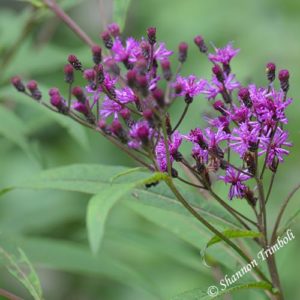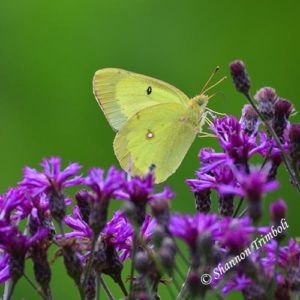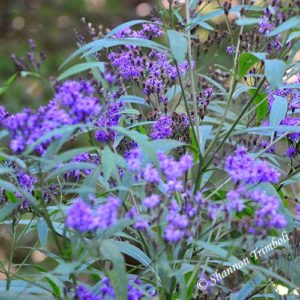Ironweeds are perennial, native wildflowers that produce beautiful, purple blooms about the time the goldenrods start to light up the fields. There are approximately 15 different species of ironweeds (Vernonia spp.) in the eastern U.S. with more out west. The most widespread species in the eastern U.S. is tall ironweed or giant ironweed (Vernonia gigantea – formerly V. altissima).
Note: Watch your common names on this one. At least one other species in the eastern U.S is commonly called tall ironweed. That’s the problem with common names – more than one species can have the same common name.

Biology and Life History
Tall ironweed can be found growing in sunny to partly sunny fields, ditches, prairies, and similar locations. Like most other ironweeds, it can grow in moist conditions. However, tall ironweed can also grow in drier soils and is perfectly happy in medium moisture soil. Once established, tall ironweed is very drought tolerant.
Like its name suggests, tall ironweed can grow quite tall – usually between 4 and 10 feet tall. Its height appears to be partly determined by genetics and partly determined by growing conditions. Tall ironweed flowers are some shade of purple ranging from magenta, to medium purple, to dark purple. It typically starts blooming in August and will continue blooming until the first frosts of the season.
Tall ironweed produces abundant seeds with small fluffy tufts that allow the seeds to be blown to new locations by the wind. In areas where tall ironweed occurs with other ironweed species, it may naturally hybridize with those other species. Tall ironweed can also spread vegetatively through rhizomes and form clumps.
Pollinator and Wildlife Uses

The flowers of tall ironweed, like other ironweeds, can be a magnet for butterflies, skippers, and many of our native bees. A couple of our native bees appear to be pollen specialists on ironweeds, which means the larvae of these species only, or almost only, eats ironweed pollen.
Ironweeds, in general, are also a host plant for several species of moth caterpillars. Some of those caterpillars will become baby bird food, and some of the caterpillars that survive to become adult moths will become bat food. There are also a couple of different types of midges that form galls in ironweeds, much like the galls that you find in some goldenrod species.
Songbirds, such as goldfinches and sparrows, will eat the ironweed seeds in the late fall and winter. Birds and small mammals may also take shelter among the ironweed stems which stay standing during the winter. Deer and other mammals tend to avoid eating ironweed foliage due to its bitter taste.
Incorporating Tall Ironweed into Your Yard
Tall ironweed can be a great addition to pollinator gardens, especially ones that have a more naturalized or less-formal style. I especially love it mixed in with goldenrods or other bright yellow flowers that bloom at the same time. I’m not sure I would recommend tall ironweed for a super formal garden style because of its potential height and ability to spread.

I prefer growing tall ironweed over some of the other ironweed species because tall ironweed can grow in drier conditions than most of our other ironweeds. However, because of its height, tall ironweed can begin to look weedy. If that becomes a problem, simply cut your tall ironweed back in late spring or early summer. Cutting it back will keep it shorter and promote bushiness.
When you first start growing tall ironweed, you may want to keep an eye on how much it spreads vegetatively in your garden. In some garden conditions, it can become a fairly aggressive spreader. In other garden conditions, it seems to behave quite well. I don’t have an easy answer for why it spreads more in some situations than others. I’ve never seen this become a problem in well-balanced, larger pollinator plantings.
Summary
Tall ironweed, like other native ironweeds, can make a great addition to a pollinator garden or pollinator planting. Butterflies (including our migratory species), skippers, bees, songbirds, and many other animals will be drawn to it. Tall ironweed also has the added benefit of being mostly avoided by deer, which can be a huge plus for people living in areas with high deer populations. If you are looking for native fall flowers that are beneficial to pollinators and your garden design tends towards the less formal style, then it’s worth considering whether tall ironweed would fit into your garden beds.

Backyard Ecology: Exploring Nature in Your Backyard
Nature isn’t just “out there.” It’s all around us, including right outside our doors. Hi, my name is Shannon Trimboli, and I am the host of Backyard Ecology. I live in southcentral Kentucky and am a wildlife biologist, educator, author, beekeeper, and owner of a nursery specializing in plants for pollinators and wildlife conservation. I invite you to join me as we ignite our curiosity and natural wonder, explore our yards and communities, and improve our local pollinator and wildlife habitat. Learn more or subscribe to my email list at www.backyardecology.net.

Leave a Reply